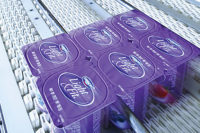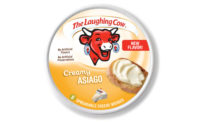

Next, home delivery service began to spread out across the Midwest: Downstate Illinois, Milwaukee, Indianapolis, St. Louis, plus stores in Missouri, Indiana and Michigan.
Earlier this year, North Aurora, Ill.-based Oberweis Dairy launched home delivery service in Virginia and is scouting locations for dairy stores there.
Through it all, one manufacturing facility, at the company’s headquarters, has served all its milk and ice cream needs. That could change as expansion continues, management acknowledges, but in the meantime, the compact plant on Ice Cream Drive near Interstate 88 works a little harder, a little faster and a little smarter to get the job done.
“I wish we were set up more like a bowling alley, where raw milk enters one side, production is linear and finished goods come out the other,” President Joe Oberweis says, discussing the challenges of production in a small facility. “Unfortunately, our setup looks more like a hub-and-spoke system, which makes processing centralized but creates inefficiencies.”
The plant features modern filling equipment, though the half-gallon glass bottles on the line are a nod to the past, as well as the company’s trademark. Memories remain fresh amid the updated processes.
“This is a little more automated than when I was a kid,” Chairman Jim Oberweis says, inspecting the bulk ice cream filler. “My dad used to fill the Dixie cups by hand.”
The company continues to update its equipment and automate processes as space and growth allow. “We’re adding a second bottle washer in the next three months and may add a second fruit feeder in the next six months,” Joe Oberweis says during a late June visit. “Our focus near-term will be on upgrading technology and redundancy, potentially adding another filling line, and automation.”

Glass act
Milk arrives at the plant from some 28 family farms that Oberweis contracts with from Illinois and Wisconsin. The single receiving bay accepts three tankers of milk per day.Marketing its status as “rBST free” long before the current trend against the synthetic hormone, Oberweis Dairy goes above and beyond most dairies, Jim Oberweis explains. “We might reject milk that other dairies would accept,” he says.
“Our farmers are required to send in samples,” explains Mark Newport, quality assurance lab manager. “We do tests on individual animals for sulfa drugs, tetracycline – we don’t want anything in that milk.”
Joe Oberweis adds: “We test for more than we’re required to,” explaining a challenge presented by the company’s relationship with its producers. “As a direct contractor with our farmers, we buy whatever milk they sell us, and balancing inflow of milk with our needs is difficult.”
After passing lab tests, the milk is offloaded, separated and stored in the raw silos. Following HTST pasteurization and standardization, milk bound for fluid products heads for the filling lines: one for the company’s signature half-gallon glass bottles (which also hold lemonade and iced tea), and another for 12-ounce and quart plastic bottles. Both are sold at Oberweis dairy stores as well as grocery retailers throughout the company’s territory.

So, what’s the typical life span of an Oberweis glass milk bottle?
“It depends where they go,” Oberweis says. “Our stores, almost 100% [returns]. Home delivery, 95%. Grocery stores, much lower.”
At the time of our visit, the company was poised to hike its bottle deposit – from 85 cents to $1.50 – to provoke a greater rate of return. “We’ve seen a significant decline in the number of bottles coming back to us,” Joe Oberweis says. “We need to give customers a financial incentive to return them. If they’re not coming back, they’re going into a landfill, which defeats the whole purpose.”
If not a landfill, then perhaps to municipal recycling, which still leaves the company out the money it paid to purchase each bottle in the first place.
But to answer the life-span question, Oberweis says it’s about a decade, with some increasingly rare exceptions. “In the last five years, I’ve had bottles come back from the 1960s,” he says, noting it’s often difficult to determine a bottle’s age by sight. “We’ve had this design for a long time.”
Bottles that make it back to the plant are visually inspected for defects or foreign objects. Then they take a trip through the bottle washer, which washes 80 bottles a minute on 20-minute cycles.

Sundae drivers
Tucked in alongside the fluid fillers, the Oberweis plant has one ice cream line that services several fillers for various packaging formats: quarts, pints and 8-ounce cups for retail sales and foodservice bulk cans used in the company’s dairy stores.A single fruit feeder, along with a purist attitude toward ice cream, keeps most Oberweis ice cream varieties simple, without too much “stuff” in them. However, a second fruit feeder may join the line soon.
Retail-size containers are filled, lidded and shrink-wrapped in bundles of six before going to the hardener, where they’re kept at -40 degrees F for at least 12 hours. Ice cream products then move to the frozen storage area, kept at 20 below, to await shipment.
Quality and taste are Oberweis Dairy’s main selling points, so QA and safety are always top of mind at the plant level.
“We pull random samples of ice cream throughout production,” Oberweis explains. “We pull samples of each variety of milk for fat testing, of course, and also micro and for shelf-life study. We send out samples of milk for third-party fresh counts and Moseley shelf-life testing.”
Food safety measures are fairly standard but meticulous nonetheless. “We get certificates of analysis on all ingredients, have an active HACCP plan in place and have training for GMPs, allergens and HACCP,” he says. “We conduct regular self audits and have annual audits by Quality Chekd [of which Oberweis Dairy is a member]. We are moving towards the SQF (Safe Quality Food) system in the next year or so.”
Consumers should purchase Oberweis products with confidence. After all, the retail store at the plant has a window in the dining room through which visitors can look into the QA lab and get a close-up view of the quality processes at work. Buyers of Oberweis products can see for themselves the results of the fourth tenet of the company’s Farmers’ Pledge: “Do nothing different than if our children and families were drinking all of the milk we produce.”

AT a glance
Oberweis DairyLocation: North Aurora, Ill.
History: Built 1996, additions in 1999 and 2006.
Size: 80,000 square feet
Employees: 140 plant; about 250 full time and 750 part time company-wide.
Products made: Milk (whole, 2%, skim, chocolate, vanilla, strawberry, NSA chocolate and vanilla), heavy cream, half & half, iced tea, lemonade, fruit punch, ice cream, ice cream pies and cakes.
Total processing capacity: 38,000 gallons daily
Pasteurization: HTST, 2,550 gallons per hour
Filling lines: Two milk fillers (one half-gallon glass, one small plastic bottle); one ice cream line for pints and 8-ounce cups; bulk ice cream filler.
Storage capacity: Raw, 120,000 gallons milk and 3,000 gallons cream; pasteurized, 46,000 gallons; cooler, 14,000 cases.

